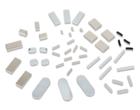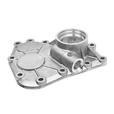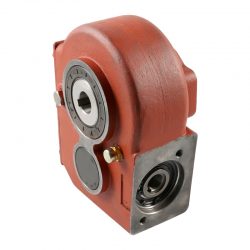Exploring the World of Ferrite Materials: Properties, Applications, and Future Prospects
Introduction
Ferrite materials have long been a cornerstone in the world of materials science and engineering. These versatile compounds, composed primarily of iron and oxygen, exhibit a wide range of unique electromagnetic and magnetic properties that make them indispensable in various applications. This article delves into the fascinating realm of ferrite materials, exploring their properties, diverse applications, and the promising future prospects they hold.
The Basics of Ferrite Materials
Composition and Structure
Ferrite materials are typically iron oxide compounds with the chemical formula Fe₃O₄. They consist of a crystal lattice structure, with iron cations (Fe²⁺ and Fe³⁺) occupying octahedral and tetrahedral sites, respectively, within the lattice. This unique arrangement gives rise to their remarkable properties.
Magnetic Properties
One of the most striking features of ferrite materials is their strong magnetic behavior. They are ferromagnetic at room temperature, making them suitable for applications in magnetic cores, transformers, and inductors. Their high magnetic permeability and low magnetic losses are particularly advantageous in electronic devices.
Electrical Properties
Ferrite materials also possess excellent electrical insulating properties, which make them suitable for high-frequency applications, such as RF (radio frequency) transformers and antennas. Their low electrical conductivity reduces eddy current losses, making them ideal for high-frequency magnetic components.
Applications of Ferrite Materials
Magnetic Cores
Ferrite cores are essential components in transformers and inductors. They help concentrate the magnetic field, enhance inductance, and reduce energy losses. These cores are used extensively in power supplies, audio transformers, and electronic circuitry.
Microwave Devices
Ferrite materials find wide-ranging applications in microwave devices, such as circulators and isolators. Their unique property of non-reciprocity in magnetic fields allows them to direct the flow of electromagnetic waves, making them crucial in radar systems and satellite communication.
Permanent Magnets
Ferrite magnets, also known as ceramic magnets, are widely used in various applications, including refrigerator magnets and magnetic toys. They are cost-effective and exhibit good resistance to demagnetization.
Ferrite Antennas
Ferrite antennas are commonly used in AM radio receivers due to their ability to efficiently tune to specific frequencies. Their high Q-factor and narrow bandwidth make them suitable for this purpose.
Magnetic Recording
Ferrite materials have played a significant role in the history of magnetic data storage, particularly in the development of early magnetic tapes. Although other technologies have largely replaced them in data storage, ferrite materials still find niche applications in magnetic sensors and read/write heads.
Recent Advances and Future Prospects
Nanoscale Ferrite Materials
Research in nanotechnology has led to the development of nanoscale ferrite materials with enhanced properties. These materials show promise in applications like targeted drug delivery, hyperthermia therapy, and magnetic resonance imaging (MRI).
Spintronics
The emerging field of spintronics exploits the intrinsic spin of electrons to create new electronic devices. Ferrite materials are being investigated for their potential use in spintronic devices, offering energy-efficient alternatives to conventional electronics.
Energy Storage
Ferrite-based materials are being explored for energy storage applications, including magnetic energy storage and inductors for power electronics. Their ability to handle high power densities makes them attractive for renewable energy systems.
Biomedical Applications
Ferrite nanoparticles are being researched for their applications in medicine, including magnetic resonance imaging (MRI) contrast agents, targeted drug delivery systems, and hyperthermia therapy for cancer treatment.
Conclusion
Ferrite materials, with their remarkable properties and diverse applications, continue to play a pivotal role in various industries. From magnetic cores to biomedical innovations, these materials have proven their versatility and adaptability. As researchers continue to push the boundaries of materials science and nanotechnology, ferrite materials are poised to play an even more significant role in shaping the technologies of the future. Their unique combination of magnetic and electrical properties ensures they will remain a fascinating area of study and application for years to come.





























































![Glyco Care Canada Reviews [BEHIND SECRET] Glyco Care Reviews, Side Effects and Where to Buy](https://socialsocial.social/btabcloud/uploads/2024/06/glyco-care-canada-171740887748lcp-250x125.png)



